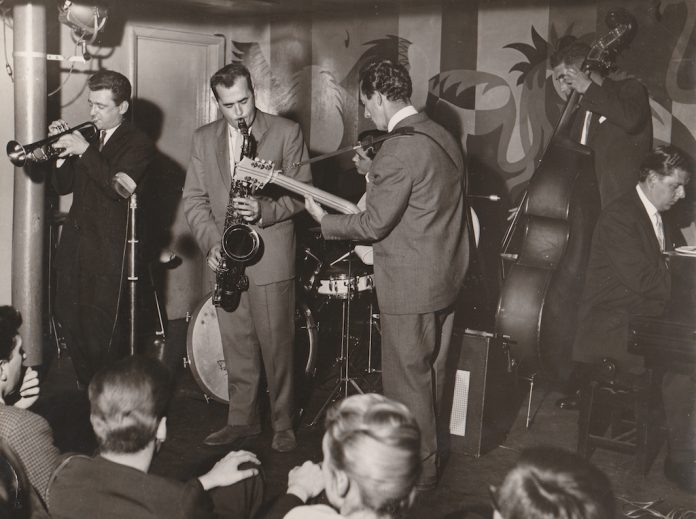Something for Ronnie’s 60th
They say that it’s easy to tell when you’ve reached middle age. It’s the moment you first go “oof!” when sitting down on the sofa. I finally realised that I had now attained the further status of Aged Survivor when the phone rang one day:
“Oh, er, Hi, er, I’m told you might be able to show me where the old Ronnie Scott’s club was”.
It was a radio reporter researching for a piece about London jazz in the 60s. So I took him to 39 Gerrard Street and we peered over the railings at the small, dank square of paving below.
“Is that it?”
“No, that’s the entrance. You went down these stairs and through that door”.
He took in the vertiginous staircase and the door that looked as though it hadn’t been opened in a very long time.
“How big was it inside?”
“Big enough for a stage and a bar and banked seating with little narrow tables”.
“Must have been a bit of a squash”.
“Where there’s a will there’s a way. Would you like to see some other places?”
So we had a look at the betting shop that used to be the Flamingo. That wasn’t very exciting, so I began casting about for anything else that might be nearby. The place in Windmill Street that had been Club Eleven and Cy Laurie’s and something else in the R&B days – that had been gutted and done out as some kind of bar. Studio 51 had disappeared years ago in rebuilding, as had the Mapleton. Since we were still in Gerrard Street, I pointed to a nearby door, I think it was a café of some sort.
“That was the El Morocco”.
“Was that a jazz club, too?”
“No, it was a nightclub with gambling. Ronnie was a regular visitor there. It belonged to the Kray Brothers”.
“Must have been a rough place”.
“Certainly not! Very smart and well behaved. You had to wear a tie”.
Places change and let you down. If you want to keep the memory bright, never go back
It was clear that any magic there may once have been in these streets had departed long ago. In fact, I found that the sight of scruffy, present-day Soho actually repressed my fond memories of scruffy, long-ago Soho. We therefore retired to licensed premises and talked of other things.
Thinking about it afterwards, I remembered Stan Getz telling me that, during his first season at Ronnie’s, in 1964, he had taken a trip to London E1, to view the wonders of Whitechapel, which his grandfather used to go on about when Stan was a boy. Same result. Places change and let you down. If you want to keep the memory bright, never go back. Be like P.G. Woodhouse, who stayed far away, guarding his imaginary world of Bertie and Jeeves and Lord Emsworth and his pig.
The premises at 39 Gerrard Street are less than half a mile away from its glossy, world-famous successor, but everything about the slightly mad, seat-of-the-pants enterprise that once inhabited the old place is unreachably distant now. Sixty years distant. Have a good party.
Louis and Lombardo
It was so embarrassing! Flaccid, saccharine and packed with cliché, surely this stuff was anti-jazz? Guy Lombardo and his Royal Canadians should have been a sitting duck to jazz critics. But while the critics, commentators and acknowledged jazz experts were busy explaining to the world in general that there was a lot more to Louis Armstrong than Hello Dolly, the man himself was announcing that he had always been one of Guy Lombardo’s biggest fans.
For a long time, this was either written off as mild eccentricity (although Louis was one of the most down-to earth, non-eccentric people imaginable), or attributed somehow to his upbringing and lack of sophistication. This was just plain daft. Louis had made his way with determination, intelligence and self possession through an upbringing that would have crushed many a lesser person. As for musicality, he conceived and played the cornet solo on Potato Head Blues; how much more do you want? No, if he said he admired Lombardo, then he did, and he would have had a reason.
Louis had heard Bunk Johnson play spirituals ‘that made me cry’, and a good tune, no matter how sentimental, would always get to him
This is how he put it: “That band plays the tune. They put that melody there and it’s beautiful. You can’t find another band that can play a straight lead and make it sound that good”. And again: “When I had my first big band I always tried to get my sax section to sound like theirs”. Give a listen to his When You’re Smiling (1929) and you’ll hear that he wasn’t kidding. Having just come from listening to most of an eight-CD set of Lombardo recordings, I can confirm that the two altos and one tenor get more than tolerably close – vibrato and all.
It seems to me that there were two factors at work here, one inside Louis and the other outside. The inside one was his devotion to melody, or, as King Oliver had called it, “straight lead”. As a kid in New Orleans, Louis had heard Bunk Johnson play spirituals “that made me cry”, and a good tune, no matter how sentimental, would always get to him. And that’s what Lombardo did, he played melodies, accurately and and in tune.
The outside factor was popularity. Louis’s stature as a performing artist had grown phenomenally in a few years, but, approaching the close of the 1920s, he was aware of its limitation. His musical idiom, his presentation, even his sense of humour, were still intimately bound up with the tastes of an African-American audience. To appeal to the population at large he would need some of what Lombardo had.


